Abstract
Epidemiological and transgenic animal studies have implicated apo C-III as a major determinant of plasma triglyceride metabolism. Since fibrates are very efficient in lowering triglycerides, it was investigated whether fibrates regulate apo C-III gene expression. Different fibrates lowered rat liver apo C-III mRNA levels up to 90% in a dose- and time-dependent manner, whereas intestinal apo C-III mRNA remained constant. This decrease in liver apo C-III mRNA was rapid (1 d) and reversible, since it was restored to control levels within 1 wk after cessation of treatment. In addition, fenofibrate treatment abolished the developmental rise of hepatic apo C-III mRNA observed during the suckling-weaning period. Administration of fibrates to rats induced liver and intestinal expression of the acyl CoA oxidase gene, the rate-limiting enzyme for peroxisomal beta-oxidation of fatty acids. In primary cultures of rat and human hepatocytes, fenofibric acid lowered apo C-III mRNA in a time- and dose-dependent manner. This reduction in apo C-III mRNA levels was accompanied by a decreased secretion of apo C-III in the culture medium of human hepatocytes. In rat hepatocytes fenofibric acid induced acyl CoA oxidase gene expression, whereas acyl CoA oxidase mRNA remained unchanged in human hepatocytes. Nuclear run-on and transient transfection experiments of a reporter construct driven by the human apo C-III gene promoter indicated that fibrates downregulate apo C-III gene expression at the transcriptional level. In conclusion, these studies demonstrate that fibrates decrease rat and human liver apo C-III gene expression. In humans the mechanisms appears to be independent of the induction of peroxisomal enzymes. This downregulation of liver apo C-III gene expression by fibrates may contribute to the hypotriglyceridemic action of these drugs.
Full text
PDF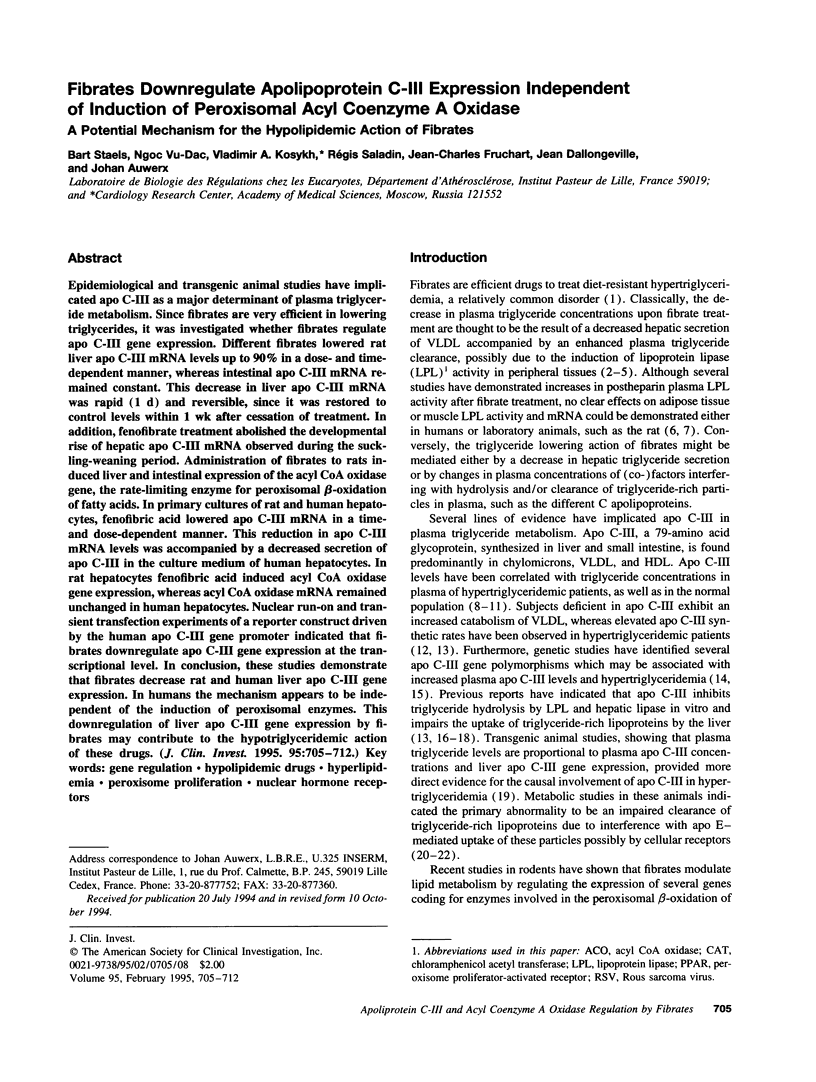
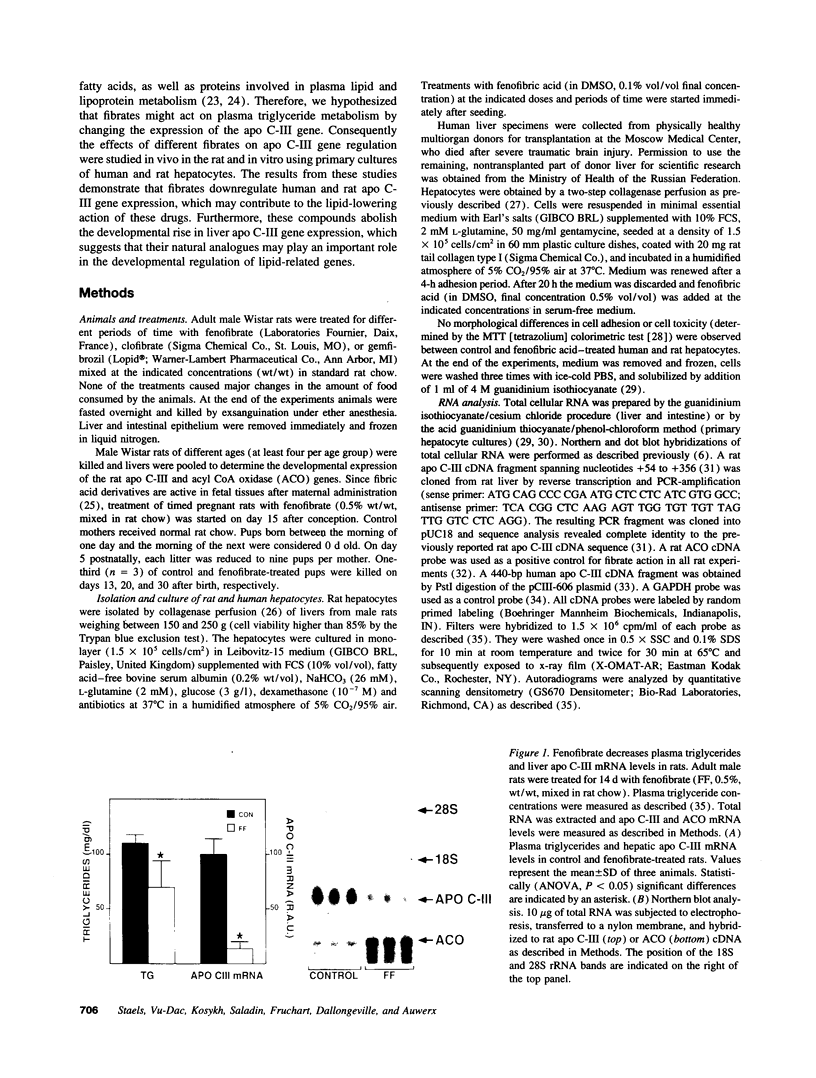
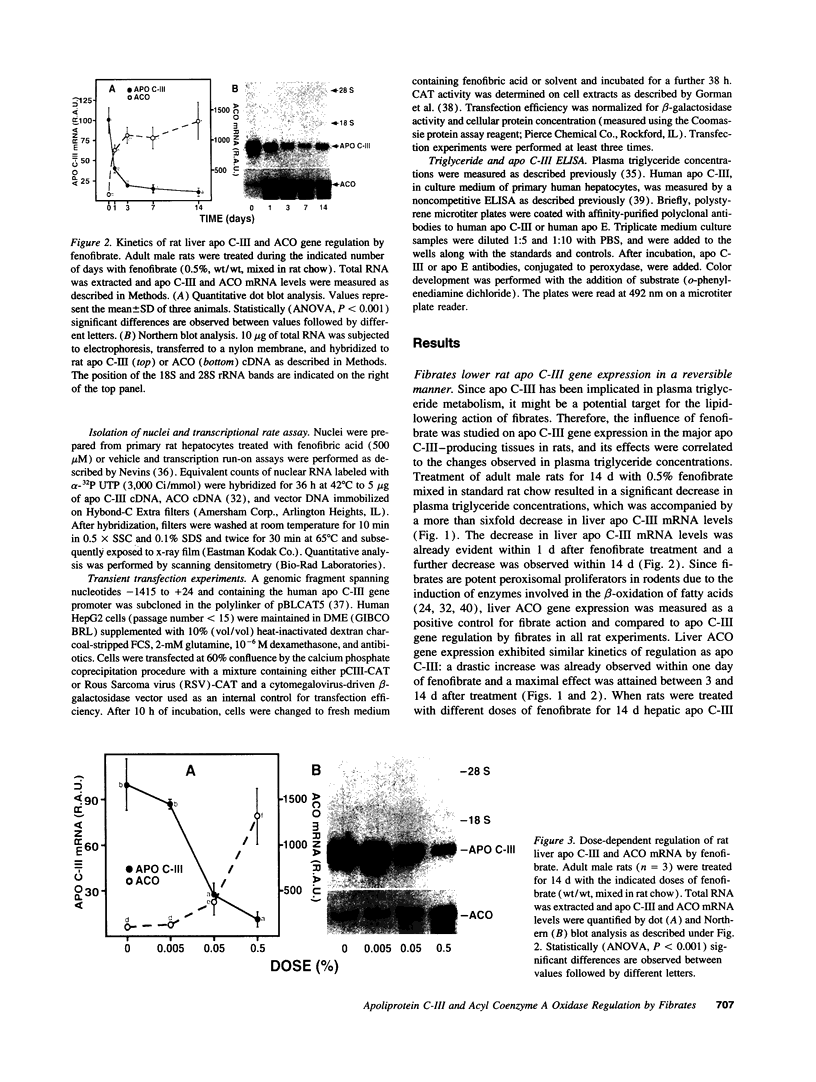
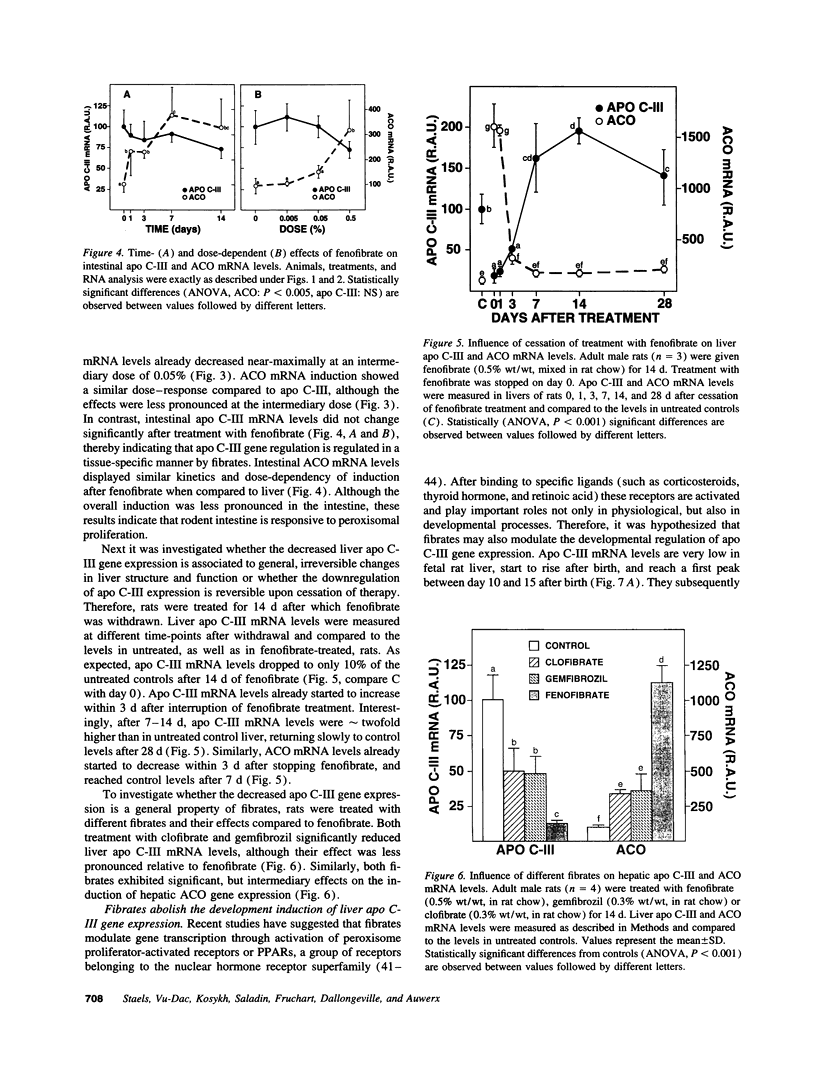
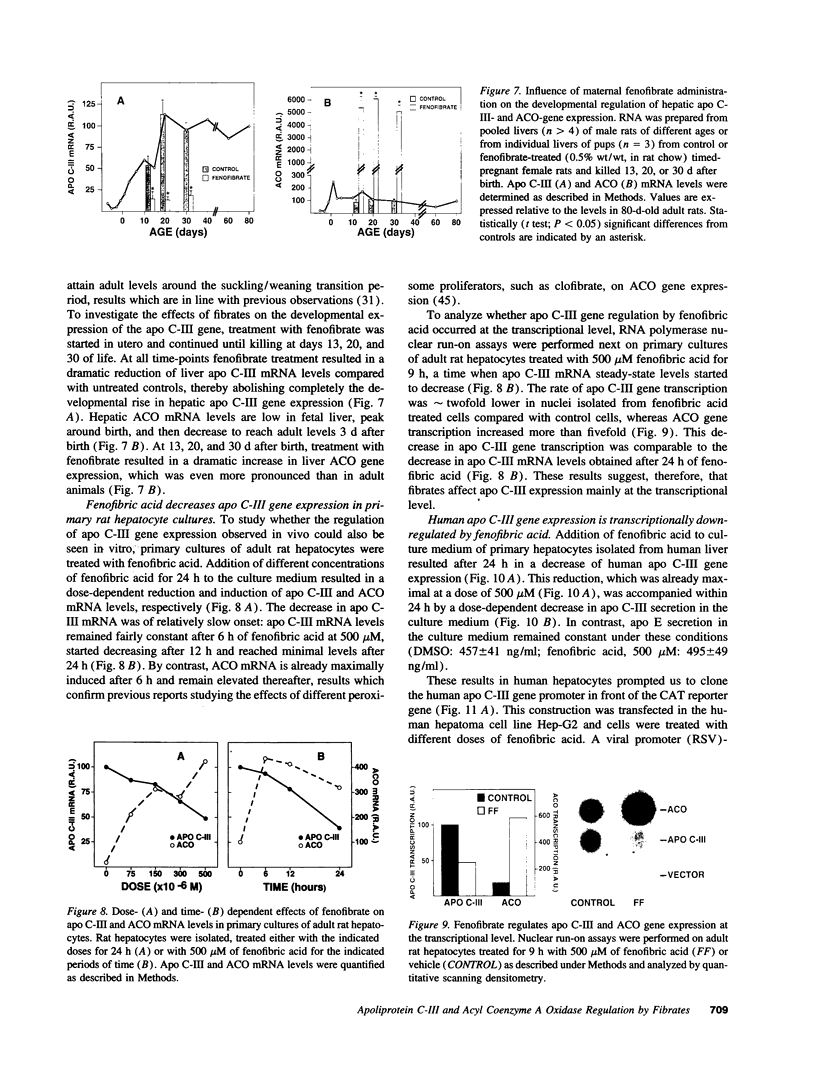
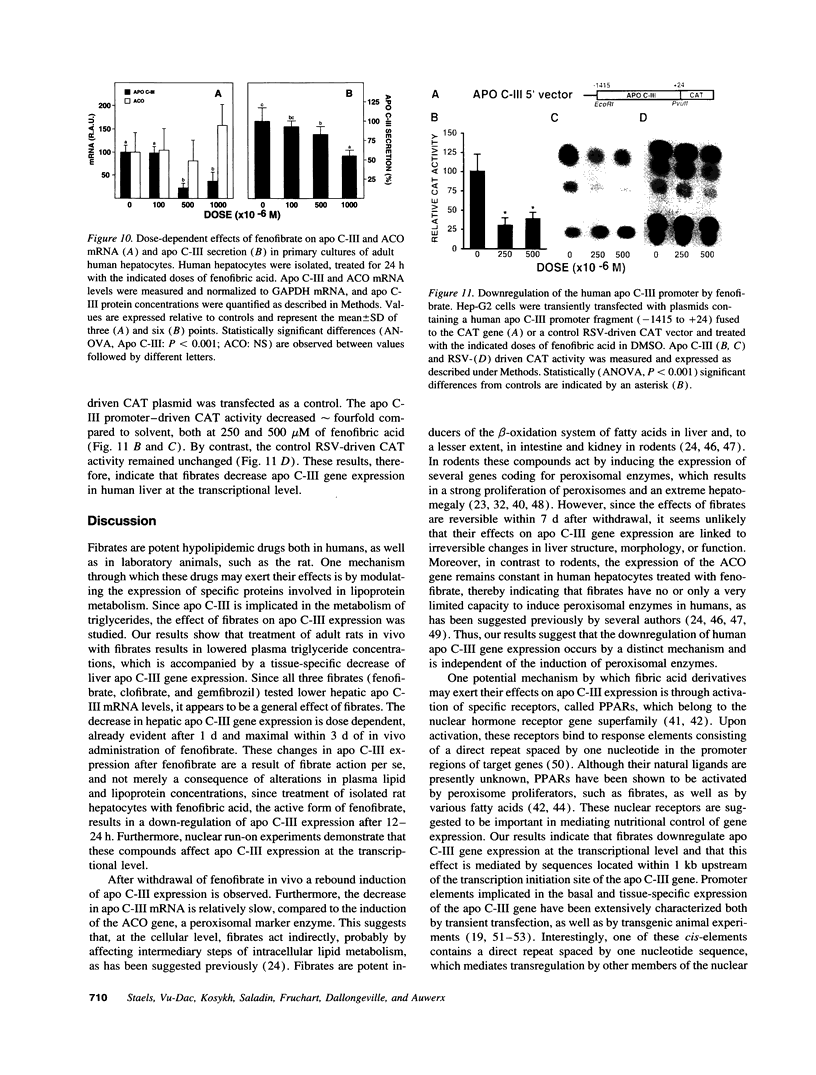
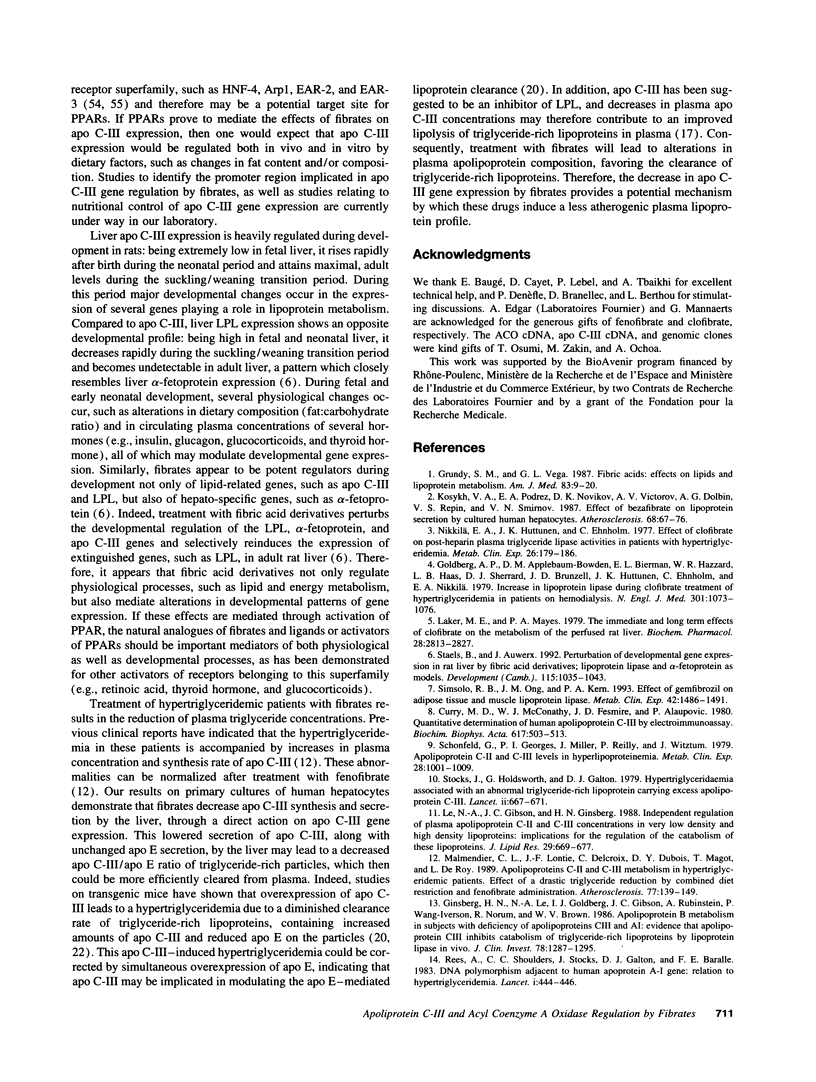
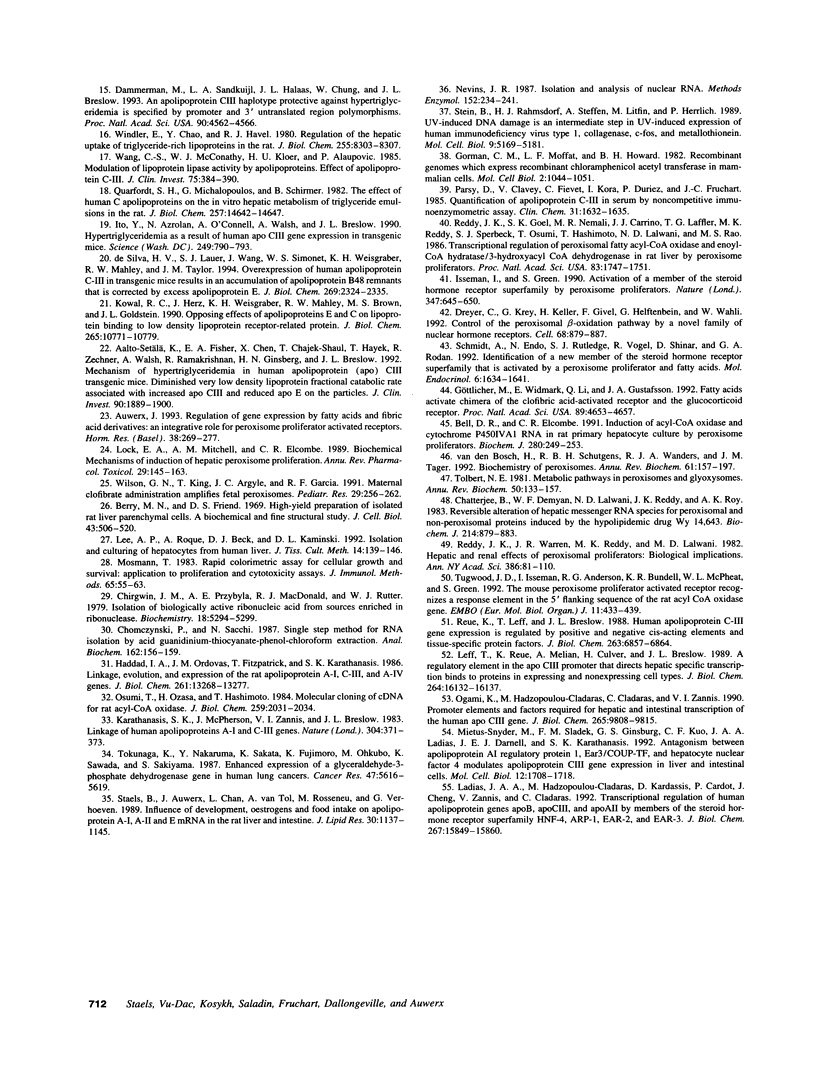
Images in this article
Selected References
These references are in PubMed. This may not be the complete list of references from this article.
- Aalto-Setälä K., Fisher E. A., Chen X., Chajek-Shaul T., Hayek T., Zechner R., Walsh A., Ramakrishnan R., Ginsberg H. N., Breslow J. L. Mechanism of hypertriglyceridemia in human apolipoprotein (apo) CIII transgenic mice. Diminished very low density lipoprotein fractional catabolic rate associated with increased apo CIII and reduced apo E on the particles. J Clin Invest. 1992 Nov;90(5):1889–1900. doi: 10.1172/JCI116066. [DOI] [PMC free article] [PubMed] [Google Scholar]
- Auwerx J. Regulation of gene expression by fatty acids and fibric acid derivatives: an integrative role for peroxisome proliferator activated receptors. The Belgian Endocrine Society Lecture 1992. Horm Res. 1992;38(5-6):269–277. doi: 10.1159/000182557. [DOI] [PubMed] [Google Scholar]
- Bell D. R., Elcombe C. R. Induction of acyl-CoA oxidase and cytochrome P450IVA1 RNA in rat primary hepatocyte culture by peroxisome proliferators. Biochem J. 1991 Nov 15;280(Pt 1):249–253. doi: 10.1042/bj2800249. [DOI] [PMC free article] [PubMed] [Google Scholar]
- Berry M. N., Friend D. S. High-yield preparation of isolated rat liver parenchymal cells: a biochemical and fine structural study. J Cell Biol. 1969 Dec;43(3):506–520. doi: 10.1083/jcb.43.3.506. [DOI] [PMC free article] [PubMed] [Google Scholar]
- Chatterjee B., Demyan W. F., Lalwani N. D., Reddy J. K., Roy A. K. Reversible alteration of hepatic messenger RNA species for peroxisomal and non-peroxisomal proteins induced by the hypolipidaemic drug Wy-14,643. Biochem J. 1983 Sep 15;214(3):879–883. doi: 10.1042/bj2140879. [DOI] [PMC free article] [PubMed] [Google Scholar]
- Chirgwin J. M., Przybyla A. E., MacDonald R. J., Rutter W. J. Isolation of biologically active ribonucleic acid from sources enriched in ribonuclease. Biochemistry. 1979 Nov 27;18(24):5294–5299. doi: 10.1021/bi00591a005. [DOI] [PubMed] [Google Scholar]
- Chomczynski P., Sacchi N. Single-step method of RNA isolation by acid guanidinium thiocyanate-phenol-chloroform extraction. Anal Biochem. 1987 Apr;162(1):156–159. doi: 10.1006/abio.1987.9999. [DOI] [PubMed] [Google Scholar]
- Curry M. D., McConathy W. J., Fesmire J. D., Alaupovic P. Quantitative determination of human apolipoprotein C-III by electroimmunoassay. Biochim Biophys Acta. 1980 Mar 21;617(3):503–513. doi: 10.1016/0005-2760(80)90016-8. [DOI] [PubMed] [Google Scholar]
- Dammerman M., Sandkuijl L. A., Halaas J. L., Chung W., Breslow J. L. An apolipoprotein CIII haplotype protective against hypertriglyceridemia is specified by promoter and 3' untranslated region polymorphisms. Proc Natl Acad Sci U S A. 1993 May 15;90(10):4562–4566. doi: 10.1073/pnas.90.10.4562. [DOI] [PMC free article] [PubMed] [Google Scholar]
- Dreyer C., Krey G., Keller H., Givel F., Helftenbein G., Wahli W. Control of the peroxisomal beta-oxidation pathway by a novel family of nuclear hormone receptors. Cell. 1992 Mar 6;68(5):879–887. doi: 10.1016/0092-8674(92)90031-7. [DOI] [PubMed] [Google Scholar]
- Ginsberg H. N., Le N. A., Goldberg I. J., Gibson J. C., Rubinstein A., Wang-Iverson P., Norum R., Brown W. V. Apolipoprotein B metabolism in subjects with deficiency of apolipoproteins CIII and AI. Evidence that apolipoprotein CIII inhibits catabolism of triglyceride-rich lipoproteins by lipoprotein lipase in vivo. J Clin Invest. 1986 Nov;78(5):1287–1295. doi: 10.1172/JCI112713. [DOI] [PMC free article] [PubMed] [Google Scholar]
- Goldberg A. P., Applebaum-Bowden D. M., Bierman E. L., Hazzard W. R., Haas L. B., Sherrard D. J., Brunzell J. D., Huttunen J. K., Ehnholm C., Nikkila E. A. Increase in lipoprotein lipase during clofibrate treatment of hypertriglyceridemia in patients on hemodialysis. N Engl J Med. 1979 Nov 15;301(20):1073–1076. doi: 10.1056/NEJM197911153012001. [DOI] [PubMed] [Google Scholar]
- Gorman C. M., Moffat L. F., Howard B. H. Recombinant genomes which express chloramphenicol acetyltransferase in mammalian cells. Mol Cell Biol. 1982 Sep;2(9):1044–1051. doi: 10.1128/mcb.2.9.1044. [DOI] [PMC free article] [PubMed] [Google Scholar]
- Grundy S. M., Vega G. L. Fibric acids: effects on lipids and lipoprotein metabolism. Am J Med. 1987 Nov 27;83(5B):9–20. doi: 10.1016/0002-9343(87)90866-7. [DOI] [PubMed] [Google Scholar]
- Göttlicher M., Widmark E., Li Q., Gustafsson J. A. Fatty acids activate a chimera of the clofibric acid-activated receptor and the glucocorticoid receptor. Proc Natl Acad Sci U S A. 1992 May 15;89(10):4653–4657. doi: 10.1073/pnas.89.10.4653. [DOI] [PMC free article] [PubMed] [Google Scholar]
- Haddad I. A., Ordovas J. M., Fitzpatrick T., Karathanasis S. K. Linkage, evolution, and expression of the rat apolipoprotein A-I, C-III, and A-IV genes. J Biol Chem. 1986 Oct 5;261(28):13268–13277. [PubMed] [Google Scholar]
- Issemann I., Green S. Activation of a member of the steroid hormone receptor superfamily by peroxisome proliferators. Nature. 1990 Oct 18;347(6294):645–650. doi: 10.1038/347645a0. [DOI] [PubMed] [Google Scholar]
- Ito Y., Azrolan N., O'Connell A., Walsh A., Breslow J. L. Hypertriglyceridemia as a result of human apo CIII gene expression in transgenic mice. Science. 1990 Aug 17;249(4970):790–793. doi: 10.1126/science.2167514. [DOI] [PubMed] [Google Scholar]
- Karathanasis S. K., McPherson J., Zannis V. I., Breslow J. L. Linkage of human apolipoproteins A-I and C-III genes. 1983 Jul 28-Aug 3Nature. 304(5924):371–373. doi: 10.1038/304371a0. [DOI] [PubMed] [Google Scholar]
- Kosykh V. A., Podrez E. A., Novikov D. K., Victorov A. V., Dolbin A. G., Repin V. S., Smirnov V. N. Effect of bezafibrate on lipoprotein secretion by cultured human hepatocytes. Atherosclerosis. 1987 Nov;68(1-2):67–76. doi: 10.1016/0021-9150(87)90095-5. [DOI] [PubMed] [Google Scholar]
- Kowal R. C., Herz J., Weisgraber K. H., Mahley R. W., Brown M. S., Goldstein J. L. Opposing effects of apolipoproteins E and C on lipoprotein binding to low density lipoprotein receptor-related protein. J Biol Chem. 1990 Jun 25;265(18):10771–10779. [PubMed] [Google Scholar]
- Ladias J. A., Hadzopoulou-Cladaras M., Kardassis D., Cardot P., Cheng J., Zannis V., Cladaras C. Transcriptional regulation of human apolipoprotein genes ApoB, ApoCIII, and ApoAII by members of the steroid hormone receptor superfamily HNF-4, ARP-1, EAR-2, and EAR-3. J Biol Chem. 1992 Aug 5;267(22):15849–15860. [PubMed] [Google Scholar]
- Laker M. E., Mayes P. A. The immediate and long term effects of clofibrate on the metabolism of the perfused rat liver. Biochem Pharmacol. 1979 Sep 15;28(18):2813–2827. doi: 10.1016/0006-2952(79)90567-7. [DOI] [PubMed] [Google Scholar]
- Le N. A., Gibson J. C., Ginsberg H. N. Independent regulation of plasma apolipoprotein C-II and C-III concentrations in very low density and high density lipoproteins: implications for the regulation of the catabolism of these lipoproteins. J Lipid Res. 1988 May;29(5):669–677. [PubMed] [Google Scholar]
- Leff T., Reue K., Melian A., Culver H., Breslow J. L. A regulatory element in the ApoCIII promoter that directs hepatic specific transcription binds to proteins in expressing and nonexpressing cell types. J Biol Chem. 1989 Sep 25;264(27):16132–16137. [PubMed] [Google Scholar]
- Lock E. A., Mitchell A. M., Elcombe C. R. Biochemical mechanisms of induction of hepatic peroxisome proliferation. Annu Rev Pharmacol Toxicol. 1989;29:145–163. doi: 10.1146/annurev.pa.29.040189.001045. [DOI] [PubMed] [Google Scholar]
- Malmendier C. L., Lontie J. F., Delcroix C., Dubois D. Y., Magot T., De Roy L. Apolipoproteins C-II and C-III metabolism in hypertriglyceridemic patients. Effect of a drastic triglyceride reduction by combined diet restriction and fenofibrate administration. Atherosclerosis. 1989 Jun;77(2-3):139–149. doi: 10.1016/0021-9150(89)90075-0. [DOI] [PubMed] [Google Scholar]
- Mietus-Snyder M., Sladek F. M., Ginsburg G. S., Kuo C. F., Ladias J. A., Darnell J. E., Jr, Karathanasis S. K. Antagonism between apolipoprotein AI regulatory protein 1, Ear3/COUP-TF, and hepatocyte nuclear factor 4 modulates apolipoprotein CIII gene expression in liver and intestinal cells. Mol Cell Biol. 1992 Apr;12(4):1708–1718. doi: 10.1128/mcb.12.4.1708. [DOI] [PMC free article] [PubMed] [Google Scholar]
- Mosmann T. Rapid colorimetric assay for cellular growth and survival: application to proliferation and cytotoxicity assays. J Immunol Methods. 1983 Dec 16;65(1-2):55–63. doi: 10.1016/0022-1759(83)90303-4. [DOI] [PubMed] [Google Scholar]
- Nevins J. R. Isolation and analysis of nuclear RNA. Methods Enzymol. 1987;152:234–241. doi: 10.1016/0076-6879(87)52025-0. [DOI] [PubMed] [Google Scholar]
- Nikkilä E. A., Huttunen J. K., Ehnholm C. Effect of clofibrate on postheparin plasma triglyceride lipase activities in patients with hypertriglyceridemia. Metabolism. 1977 Feb;26(2):179–186. doi: 10.1016/0026-0495(77)90053-1. [DOI] [PubMed] [Google Scholar]
- Ogami K., Hadzopoulou-Cladaras M., Cladaras C., Zannis V. I. Promoter elements and factors required for hepatic and intestinal transcription of the human ApoCIII gene. J Biol Chem. 1990 Jun 15;265(17):9808–9815. [PubMed] [Google Scholar]
- Osumi T., Ozasa H., Hashimoto T. Molecular cloning of cDNA for rat acyl-CoA oxidase. J Biol Chem. 1984 Feb 25;259(4):2031–2034. [PubMed] [Google Scholar]
- Parsy D., Clavey V., Fievet C., Kora I., Duriez P., Fruchart J. C. Quantification of apolipoprotein C-III in serum by a noncompetitive immunoenzymometric assay. Clin Chem. 1985 Oct;31(10):1632–1635. [PubMed] [Google Scholar]
- Quarfordt S. H., Michalopoulos G., Schirmer B. The effect of human C apolipoproteins on the in vitro hepatic metabolism of triglyceride emulsions in the rat. J Biol Chem. 1982 Dec 25;257(24):14642–14647. [PubMed] [Google Scholar]
- Reddy J. K., Goel S. K., Nemali M. R., Carrino J. J., Laffler T. G., Reddy M. K., Sperbeck S. J., Osumi T., Hashimoto T., Lalwani N. D. Transcription regulation of peroxisomal fatty acyl-CoA oxidase and enoyl-CoA hydratase/3-hydroxyacyl-CoA dehydrogenase in rat liver by peroxisome proliferators. Proc Natl Acad Sci U S A. 1986 Mar;83(6):1747–1751. doi: 10.1073/pnas.83.6.1747. [DOI] [PMC free article] [PubMed] [Google Scholar]
- Reddy J. K., Warren J. R., Reddy M. K., Lalwani N. D. Hepatic and renal effects of peroxisome proliferators: biological implications. Ann N Y Acad Sci. 1982;386:81–110. doi: 10.1111/j.1749-6632.1982.tb21409.x. [DOI] [PubMed] [Google Scholar]
- Rees A., Shoulders C. C., Stocks J., Galton D. J., Baralle F. E. DNA polymorphism adjacent to human apoprotein A-1 gene: relation to hypertriglyceridaemia. Lancet. 1983 Feb 26;1(8322):444–446. doi: 10.1016/s0140-6736(83)91440-x. [DOI] [PubMed] [Google Scholar]
- Reue K., Leff T., Breslow J. L. Human apolipoprotein CIII gene expression is regulated by positive and negative cis-acting elements and tissue-specific protein factors. J Biol Chem. 1988 May 15;263(14):6857–6864. [PubMed] [Google Scholar]
- Schmidt A., Endo N., Rutledge S. J., Vogel R., Shinar D., Rodan G. A. Identification of a new member of the steroid hormone receptor superfamily that is activated by a peroxisome proliferator and fatty acids. Mol Endocrinol. 1992 Oct;6(10):1634–1641. doi: 10.1210/mend.6.10.1333051. [DOI] [PubMed] [Google Scholar]
- Schonfeld G., George P. K., Miller J., Reilly P., Witztum J. Apolipoprotein C-II and C-III levels in hyperlipoproteinemia. Metabolism. 1979 Oct;28(10):1001–1010. doi: 10.1016/0026-0495(79)90004-0. [DOI] [PubMed] [Google Scholar]
- Simsolo R. B., Ong J. M., Kern P. A. Effect of gemfibrozil on adipose tissue and muscle lipoprotein lipase. Metabolism. 1993 Nov;42(11):1486–1491. doi: 10.1016/0026-0495(93)90203-z. [DOI] [PubMed] [Google Scholar]
- Staels B., Auwerx J., Chan L., van Tol A., Rosseneu M., Verhoeven G. Influence of development, estrogens, and food intake on apolipoprotein A-I, A-II, and E mRNA in rat liver and intestine. J Lipid Res. 1989 Aug;30(8):1137–1145. [PubMed] [Google Scholar]
- Staels B., Auwerx J. Perturbation of developmental gene expression in rat liver by fibric acid derivatives: lipoprotein lipase and alpha-fetoprotein as models. Development. 1992 Aug;115(4):1035–1043. doi: 10.1242/dev.115.4.1035. [DOI] [PubMed] [Google Scholar]
- Stein B., Rahmsdorf H. J., Steffen A., Litfin M., Herrlich P. UV-induced DNA damage is an intermediate step in UV-induced expression of human immunodeficiency virus type 1, collagenase, c-fos, and metallothionein. Mol Cell Biol. 1989 Nov;9(11):5169–5181. doi: 10.1128/mcb.9.11.5169. [DOI] [PMC free article] [PubMed] [Google Scholar]
- Stocks J., Holdsworth G., Galton D. Hypertriglyceridaemia associated with an abnormal triglyceride-rich lipoprotein carrying excess apolipoprotein C-III-2. Lancet. 1979 Sep 29;2(8144):667–671. doi: 10.1016/s0140-6736(79)92068-3. [DOI] [PubMed] [Google Scholar]
- Tokunaga K., Nakamura Y., Sakata K., Fujimori K., Ohkubo M., Sawada K., Sakiyama S. Enhanced expression of a glyceraldehyde-3-phosphate dehydrogenase gene in human lung cancers. Cancer Res. 1987 Nov 1;47(21):5616–5619. [PubMed] [Google Scholar]
- Tolbert N. E. Metabolic pathways in peroxisomes and glyoxysomes. Annu Rev Biochem. 1981;50:133–157. doi: 10.1146/annurev.bi.50.070181.001025. [DOI] [PubMed] [Google Scholar]
- Tugwood J. D., Issemann I., Anderson R. G., Bundell K. R., McPheat W. L., Green S. The mouse peroxisome proliferator activated receptor recognizes a response element in the 5' flanking sequence of the rat acyl CoA oxidase gene. EMBO J. 1992 Feb;11(2):433–439. doi: 10.1002/j.1460-2075.1992.tb05072.x. [DOI] [PMC free article] [PubMed] [Google Scholar]
- Wang C. S., McConathy W. J., Kloer H. U., Alaupovic P. Modulation of lipoprotein lipase activity by apolipoproteins. Effect of apolipoprotein C-III. J Clin Invest. 1985 Feb;75(2):384–390. doi: 10.1172/JCI111711. [DOI] [PMC free article] [PubMed] [Google Scholar]
- Wilson G. N., King T., Argyle J. C., Garcia R. F. Maternal clofibrate administration amplifies fetal peroxisomes. Pediatr Res. 1991 Mar;29(3):256–262. doi: 10.1203/00006450-199103000-00007. [DOI] [PubMed] [Google Scholar]
- Windler E., Chao Y., Havel R. J. Regulation of the hepatic uptake of triglyceride-rich lipoproteins in the rat. Opposing effects of homologous apolipoprotein E and individual C apoproteins. J Biol Chem. 1980 Sep 10;255(17):8303–8307. [PubMed] [Google Scholar]
- de Silva H. V., Lauer S. J., Wang J., Simonet W. S., Weisgraber K. H., Mahley R. W., Taylor J. M. Overexpression of human apolipoprotein C-III in transgenic mice results in an accumulation of apolipoprotein B48 remnants that is corrected by excess apolipoprotein E. J Biol Chem. 1994 Jan 21;269(3):2324–2335. [PubMed] [Google Scholar]
- van den Bosch H., Schutgens R. B., Wanders R. J., Tager J. M. Biochemistry of peroxisomes. Annu Rev Biochem. 1992;61:157–197. doi: 10.1146/annurev.bi.61.070192.001105. [DOI] [PubMed] [Google Scholar]










